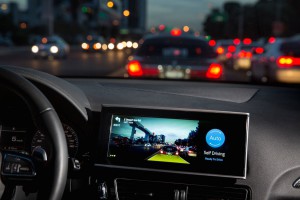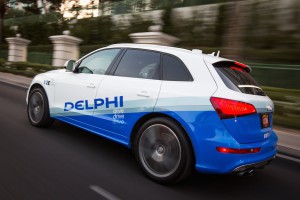
Delphi is revealing updates to its autonomous vehicle at CES that allow drivers to control cabin temps or radio stations with eye movements or hand gestures.
It’s not enough for a car or crossover to drive itself anymore apparently as Delphi Automotive is working on the next step in autonomous vehicles that can be controlled at the bat of an eyelash.
Well, it’s not quite that simple, but Delphi is bringing its self-driving vehicle to CES 2016, the show formerly known as the Consumer Electronics Show, in Las Vegas next month and it’ll be chock full of new abilities.
The new functionality permits drivers to change the temperature inside the car as well as the radio stations with eye movements and hand gestures. In terms of what the “driver” sees, that person can create a customized three-dimensional instrument panel layout that can look like a 2016 Chevy Corvette or a ’60s era Ford Mustang.
Additionally, you’ll see cup holders that wirelessly charge smartphones and the Audi SQ5 that the supplier drove across the U.S. earlier this year now has even more electronics that amp the V2V connectivity as interaction with buildings, traffic lights as well as pedestrians.
(Delphi show automated driving system with SF-to-NYC trek. For more, Click Here.)
The idea is to make the autonomous experience as effortless, but also as safe as possible, according to Jeff Owens, Delphi executive vice president and chief technical officer.
“We imagine a world with zero traffic accidents,” he said in a statement. “To get there we will need a convergence of active safety, sensor fusion, connectivity platforms and advanced software. Delphi has proven we are the only company that has the right mix of all of these.”
The supplier will use CES to show off it’s advancements in V2E including:
- Vehicle-to-vehicle: Delphi’s car can see all the cars in the immediate vicinity and can detect when an adjacent car abruptly decides to get into the same lane as the Delphi car.
- Vehicle-to-pedestrian: Leveraging a special chip in a smart phone, the vehicle is alerted to pedestrians who are not paying attention to traffic as they use their phone.
- Vehicle-to-traffic light: With Dedicated Short Range Communications (DSRC), Delphi’s vehicle knows the status of traffic lights around Vegas and will anticipate yellow and red lights.
- Blind Corners: Delphi’s vehicle manages for situations when streets intersect at strange angles that prevent the driver from seeing opposing traffic.
- Ride Sharing: The driver’s friends and family can be notified of the driver’s location so that a ride can be requested.
(Click Here for more about the impact of the newly passed Transportation Bill.)
While the future of truly automated driving is a long-term development, Delphi currently engineers and manufactures advanced systems that integrate cameras, radars, sensors and software to increase road safety.
It put many of those to use earlier this year when it piled them all into an Audi Q5 and let it drive 3,500 miles from the Golden Gate Bridge in San Francisco to New York City. At the time, it was believed to be the longest U.S. trek for an autonomous vehicle.
(To find out what the Paris Climate Change Agreement will mean for motorists, Click Here.)
The supplier is parlaying that experience and other testing to ensure it’s equipment won’t fail in future applications, such as the Super Cruise system on the 2017 Cadillac CTS. At CES, Delphi will unveil another industry-first with an aftermarket V2V unit that will enable all equipped vehicles to talk with one another – not just those built with the technology in the factory.


“We imagine a world with zero traffic accidents,”
Too bad they didn’t imagine adequate ignition switch detents for GM when they knew the design was obviously inadequate long before the likewise inadequate revised part was signed off by
De Georgio at GM .
correction :
may have known the design was inadequate
These are not next gen options for AVs, they are mandatory basic controls that all AVs allowed on the roadway require less the foolish hand and eye movement controls which are guaranteed to get people killed. It’s amazing how many people “operate in a vacuum” when it comes to engineering. They are so Hell bent on coming up with impractical uses for tech that they can’t see the forest from the trees. That gets innocent people killed.